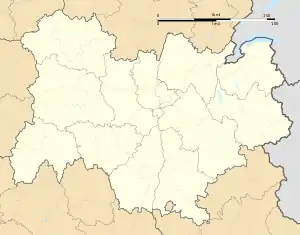Salers | |
|---|---|
 The town hall in Salers | |
 Coat of arms | |
Location of Salers | |
 Salers  Salers | |
| Coordinates: 45°08′20″N 2°29′42″E / 45.1389°N 2.495°E | |
| Country | France |
| Region | Auvergne-Rhône-Alpes |
| Department | Cantal |
| Arrondissement | Mauriac |
| Canton | Mauriac |
| Intercommunality | Pays de Salers |
| Government | |
| • Mayor (2020–2026) | Jean-Louis Faure[1] |
| Area 1 | 4.85 km2 (1.87 sq mi) |
| Population | 316 |
| • Density | 65/km2 (170/sq mi) |
| Time zone | UTC+01:00 (CET) |
| • Summer (DST) | UTC+02:00 (CEST) |
| INSEE/Postal code | 15219 /15140 |
| Elevation | 830–1,207 m (2,723–3,960 ft) (avg. 951 m or 3,120 ft) |
| 1 French Land Register data, which excludes lakes, ponds, glaciers > 1 km2 (0.386 sq mi or 247 acres) and river estuaries. | |
Salers (French pronunciation: [saˈlɛʁ], Occitan: Salèrn) is a commune in the Cantal department in south-central France.
It is famous for the Appellation d'Origine Contrôlée (AOC) cheeses Cantal and Salers. It is also famous for the Salers breed of cattle that originated in this commune.
It was pillaged by Rodrigo de Villandrando in the late 1430s, during the final phase of the Hundred Years' War.
Population
| Year | Pop. | ±% p.a. |
|---|---|---|
| 1968 | 521 | — |
| 1975 | 480 | −1.16% |
| 1982 | 451 | −0.89% |
| 1990 | 439 | −0.34% |
| 1999 | 401 | −1.00% |
| 2009 | 361 | −1.05% |
| 2014 | 341 | −1.13% |
| 2020 | 321 | −1.00% |
| Source: INSEE[3] | ||
See also
References
- ↑ "Répertoire national des élus: les maires". data.gouv.fr, Plateforme ouverte des données publiques françaises (in French). 9 August 2021.
- ↑ "Populations légales 2021". The National Institute of Statistics and Economic Studies. 28 December 2023.
- ↑ Population en historique depuis 1968, INSEE
Wikimedia Commons has media related to Salers.
This article is issued from Wikipedia. The text is licensed under Creative Commons - Attribution - Sharealike. Additional terms may apply for the media files.